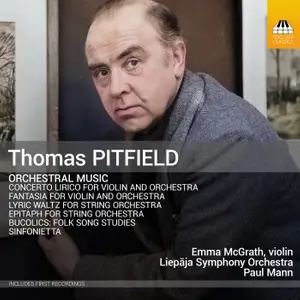
Thomas Pitfield (1903-1999)
Orchestral Music
Sinfonietta (1946)
Fantasia on an Old Staffordshire Tune, for violin and orchestra (1950)
Lyric Waltz (1988)
Bucolics; Folk Song Studies (undated)
Concerto Lirico for violin and orchestra (1958)
Epitaph for string orchestra (1981)
Emma McGrath (violin)
Liepāja Symphony Orchestra / Paul Mann
rec. 2025, Great Amber Concert Hall, Liepāja, Latvia
Toccata Classics TOCC0765 [75]
A discerning approach to this distinguished recording requires one to appreciate that Thomas Pitfield was a true polymath: a composer, poet, artist and craftsman of notable versatility. His musical language reveals the influence of Frederick Delius, Ralph Vaughan Williams and Percy Grainger, yet always retains an individual character. Unhesitant in his engagement with folk song, Pitfield resourcefully integrates it into a classical context. That yields compositions distinguished by appealing melodies, sophisticated harmonic treatment, and a sensitivity to instrumental technique.
Recorderist John Turner is a trustee of the Pitfield Trust. I am beholden to him for the excellent liner notes.
This is not the forum to discuss the differences between a symphony and a sinfonietta, save to say the latter is not necessarily lightweight. Just think of sinfoniettas by Britten, Janáček and Moeran to realise that there may be considerable depth of feeling and technical prowess.
Pitfield’s Sinfonietta begins with a sense of grandeur, and then the music alternates between light and reflective moods. Though it appears to be structured in five distinct movements, the liner notes suggest that it falls somewhere between a suite and a set of variations. There is, to this listener, little in the way of formal or thematic balance normally expected of a symphony. The movements include a surprisingly involved Polka, a heart-breaking Pavan and a lively but serious Jig. The long Finale bounces along with backward glances towards more troubling matters. Whatever the formal impediments are, this is an enjoyable and satisfying from the first note to the last. It deserves a place in the large catalogue of (sadly) rarely played British symphonic music.
The Fantasia on an Old Staffordshire Tune for violin and orchestra was first heard at the 1951 Festival of Britain; John Barbirolli conducted the Hallé Orchestra. The Daily News (10 August 1951, p.4) reports on the “interesting” new work, and how it “impressed one as an earnest piece of writing, attractive above all in its quieter moments.” Up to a point, I agree with the critic. There are moments when one is reminded of the pastoral magic of RVW’s The Lark Ascending, or Julius Harrison’s Bredon Hill. Yet, the faster passages are intriguing and provide a thoughtful contrast to the opening and closing sections which contain the heart and soul of this Fantasia. The finale, Andante contemplativo, opens with a cadenza that nods to an Ascending Lark. The overall effect is one of warmth tempered by introspection. The Old Tune is based on The Little Room, a melody that Pitfield had found in Staffordshire; he later revisited it in his Bucolics.
Pitfield scored the late Lyric Waltz for a variety of instrumental resources, including the recorder, cello and piano trio, and for piano solo. Its lovely wistful air reminds me of many sympathetic pieces written for this medium.
There follow Bucolics: Folk song Studies,not dated – Turner suggests that it may be a late piece. The collection is based on a series of six Scottish, English and Irish tunes, skillfully developed. Highlights include the opening Comin’ through the rye, the bouncy Where are you going to, my Pretty Maid, the intense My little room (already mentioned) and the entertaining Carrion Crow. The latter concerns a pistol shot, poorly aimed, which missed its intended mark, a crow, and instead struck and killed the farmer’s sow.
The story of the Concerto Lirico for violin and orchestra was not happy at first. It was premiered by the BBC Northern Orchestra under George Hurst, who gave it a less than satisfactory performance. After the broadcast, Pitfield largely destroyed the manuscript, keeping only the slow movement dedicated to a colleague and friend, the pianist Albert Hardie. Fortunately, he forgot that he had made a microfilm copy of the concerto. John Turner, Pitfield’s executor, discovered it when clearing out his garden shed [!]. It was latterly typeset by Peter Mountain, giving the English music enthusiast a first-class concerto.
There are many stylistic nods in this work, including those to E.J. Moeran and Gerald Finzi. The concerto stands as a timeless masterpiece, embodying the hallmarks of a composer who – as Rob Barnett has said in his review of a release on Dutton Epoch – “held true to his style” resisting the “contemporary tidal surge of dissonance”.
The programme ends with the deeply felt Epitaph for string orchestra. It is an adaptation of part of a cantata dedicated to the great Northumberland-born bass Owen Brannigan. It was originally a setting of one of Pitfield’s own poems reflecting on the elders of a village who rest beneath weathered, moss-covered gravestones, their inscriptions fading with time. It has been transformed into a deeply moving number on a par with much English pastoral music. It is my favourite composition on this disc.
All the works get committed performances by the Liepāja Symphony Orchestra under Paul Mann. The violin soloist, Emma McGrath, gives outstanding accounts of the two concerted pieces. I have already mentioned the liner notes, which add value and interest to the package. The recording is splendid.
This is altogether a valuable exploration of Thomas Pitfield’s eminently approachable music. One hopes that Toccata Classics will soon re-examine his extensive catalogue.
John France
Previous review: Jonathan Woolf (June 2025)
Buying this recording via a link below generates revenue for MWI, which helps the site remain free




















